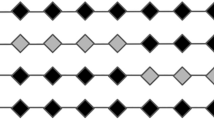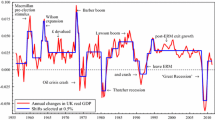Abstract
Uplift modeling corresponds to an area of machine learning focused on capturing causal relationships on various observational and experimental data. Currently it has several applications, particularly in the marketing area, focused on customer segmentation and the establishment of advertising campaigns. This research proposes an novel economic uplift approach, using branching causal algorithms to estimate the individual treatment effect on real GDP growth and changes in expansionary economic policy on a quarterly basis from an OECD dataset. The developed framework reveals positive causal effects on economic growth driven by expansionary policies, generalized for all countries under study. In addition, lagged causal effects on these policies, exerted by the economic cycle, are captured. The results obtained not only show a performance similar to that of the literature, but also conform to the theoretical and actual macroeconomic behavior.







Similar content being viewed by others
Data Availability
All the data were downloaded and are available from: (a) URL: https://databank.worldbank.org. (b) URL: https://data.oecd.org/.
References
Amaral A, Dyhoum T, Abdou H, Aljohani H (2022) Modeling for the relationship between monetary policy and GDP in the USA using statistical methods. Mathematics 10:4137. https://doi.org/10.3390/math10214137
Amiri A, Gerdtham U (2012) Granger causality between exports, imports and GDP in France: evidence from using geostatistical models. Econ Res Guard 2:43–59
Athey S, Imbens G (2019) Machine learning methods that economists should know about. Ann Rev Econ 11:685–725
Avouyi-Dovi S, Matheron J (2005) Interactions between business cycles, financial cycles and monetary policy: stylised facts. Invest Relat Financ Real Econ 22:273–98
Balk B, Reich U (2008) Additivity of national accounts reconsidered. J Econ Soc Meas 33:165–178
Bantis E, Clements M, Urquhart A (2022) Forecasting GDP growth rates in the United States and Brazil using Google Trends. Int J Forecast (In Press)
Beaudreau B (2010) On the methodology of energy-GDP Granger causality tests. Energy 35:3535–3539
Becher M, Krol J (2020) Multiple treatments for uplift modeling. GitHub Repository. https://github.com/charlespwd/Matthias2193/APA
Calderón C, Schmidt-Hebbel K (2008) Business cycles and fiscal policies: the role of institutions and financial markets (Central Bank of Chile). https://ideas.repec.org/p/chb/bcchwp/481.html
Dempster A (1990) Causality and statistics. J Stat Plan Inference 25:261–278
Devriendt F, Moldovan D, Verbeke W (2018) A literature survey and experimental evaluation of the state-of-the-art in uplift modeling: a step** stone toward the development of prescriptive analytics. Big Data 6:13–41
Dietterich TG (2000) Ensemble methods in machine learning. In: Multiple Classifier Systems: First International Workshop, MCS 2000 Cagliari, Italy, June 21–23, 2000 Proceedings 1. Springer Berlin Heidelberg, pp 1–15
Granger C (1988) Causality, cointegration, and control. J Econ Dyn Control 12:551–559
Gubela, Robin M, Lessmann, Stefan (2020) Uplift Forest for Multiple Treatments and Continuous Outcomes. Proceedings of International Conference on Information Systems (ICIS)
Gubela RM, Lessmann S, Haupt J, Baumann A, Radmer T, Gebert F (2017) Revenue Uplift Modeling. Proceedings of the 38th International Conference on Information Systems (ICIS)
Gutierrez P, Gérardy JY (2017) Causal inference and uplift modelling: A review of the literature. In: International conference on predictive applications and APIs. PMLR, pp 1–13
Holland P (1986) Statistics and causal inference. J Am Stat Assoc 81:945–960
Hsing Y (2019) Is expansionary fiscal and monetary policy effective in Australia? Asian J Bus Environ 9:5–9
Jerić S, Zoričić D, Dolinar D (2020) Analysis of forecasts of GDP growth and inflation for the Croatian economy. Econ Res-Ekon Istraž 33:310–330
Lo V, Pachamanova D (2015) From predictive uplift modeling to prescriptive uplift analytics: a practical approach to treatment optimization while accounting for estimation risk. J Mark Anal 3:79–95
Luetkepohl H, Xu F (2009) The role of the log transformation in forecasting economic variables. Emp Econ 42:619–638
Lyeonov S, Pimonenko T, Bilan Y, Štreimikienė D, Mentel G (2019) Assessment of green investments’ impact on sustainable development: linking gross domestic product per capita, greenhouse gas emissions and renewable energy. Energies 12:3891
Meng H, Qiao X (2022) Augmented direct learning for conditional average treatment effect estimation with double robustness. Electron J Stat 16:3523–3560
Nauta M, Bucur D, Seifert C (2019) Causal discovery with attention-based convolutional neural networks. Mach Learn Knowl Extr 1:312–340
Olaya D, Vásquez J, Maldonado S, Miranda J, Verbeke W (2020) Uplift modeling for preventing student dropout in higher education. Decis Support Syst 134:113320
Olaya D, Coussement K, Verbeke W (2020) A survey and benchmarking study of multitreatment uplift modeling. Data Min Knowl Discov 34, 273-308.
Radcliffe N (2007) Using control groups to target on predicted lift: building and assessing uplift model. Dir Mark Anal J 1, 14–21
Ranzato F, Zanella M (2020) Abstract interpretation of decision tree ensemble classifiers. Proc AAAI Confer Artif Intell 34:5478–5486
Rombaut E, Guerry M (2019) The effectiveness of employee retention through an uplift modeling approach. Int J Manpow 41(8):1199–1220
Rosenbaum P, Rubin D (1983) The central role of the propensity score in observational studies for causal effects. Biometrika 70:41–55
Roush J, Siopes K, Hu G (2017) Predicting gross domestic product using autoregressive models. In: 2017 IEEE 15th International Conference on Software Engineering Research, Management and Applications (SERA), pp 317–322
Rubin D (1972) Estimating causal effects of treatments in experimental and observational studies. ETS Resd Bull Ser 1972:i–31
Rzepakowski P, Jaroszewicz S (2012) Uplift modeling in direct marketing. J Telecommun Inf Technol 2:43–50
Shojaie A, Fox E (2022) Granger causality: a review and recent advances. Ann Rev Stat Appl 9:289–319
Vegetabile BG (2021) On the Distinction Between" Conditional Average Treatment Effects"(CATE) and" Individual Treatment Effects"(ITE) Under Ignorability Assumptions. ar**v preprint ar**v:2108.04939
Wager S, Athey S (2018) Estimation and inference of heterogeneous treatment effects using random forests. J Am Stat Assoc 113:1228–1242
Yuan Y, Wu L, Zhang X (2021) Gini-impurity index analysis. IEEE Trans Inf Forens Secur 16:3154–3169
Zhao Z, Harinen T (2019) Uplift Modeling for Multiple Treatments with Cost Optimization. 2019 IEEE International Conference On Data Science And Advanced Analytics (DSAA). pp. 422-431
Zimmermann A (2008) Ensemble-trees: leveraging ensemble power inside decision trees
Acknowledgements
This study was supported by ANID Fondecyt 1200555 fund.
Author information
Authors and Affiliations
Corresponding author
Ethics declarations
Conflict if interest
The authors have no relevant financial or non-financial interests to disclose.
Consent to participate
The study does not involve Human Participants. The study does not involve Animals.
Consent to publish
The authors agreed with the content and gave explicit consent to submit the manuscript.
Additional information
Publisher's Note
Springer Nature remains neutral with regard to jurisdictional claims in published maps and institutional affiliations.
Appendix
Appendix
See Appendix Tables 1, 2, 3, 4, 5.
Rights and permissions
Springer Nature or its licensor (e.g. a society or other partner) holds exclusive rights to this article under a publishing agreement with the author(s) or other rightsholder(s); author self-archiving of the accepted manuscript version of this article is solely governed by the terms of such publishing agreement and applicable law.
About this article
Cite this article
Bermeo, C., Michell, K. & Kristjanpoller, W. Estimation of causality in economic growth and expansionary policies using uplift modeling. Neural Comput & Applic 35, 13631–13645 (2023). https://doi.org/10.1007/s00521-023-08397-0
Received:
Accepted:
Published:
Issue Date:
DOI: https://doi.org/10.1007/s00521-023-08397-0




